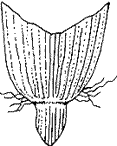Bermudagrass
Cynodon dactylon
A warm-season perennial that creeps by strong rhizomes and stolons and forms an excellent turfgrass. Most improved hybrid varieties are planted by stolons or sod. Often found as a wiry, spreading weed in northern states. Common south of a line from Maryland to Kansas and northern California.
- Stolons: Present, long
- Rhizomes: Present
- Leaves: Folded in the bud
- Ligule: A fringe of hairs
- Collar: Narrow, covered with long hairs
- Auricles: Absent
- Sheaths: Strongly compressed, sparsely hairy
- Blades: Short, 1/8th inch wide, rough along the edges, sharp pointed
- Seedhead: 3 to 5 slender spikes, joining at the top of the main stem
- Spikelets: Oval, in two rows, containing a single seed
Recommendations
- Mowing Height
- Hybrid: 0.5 to 1.25 inches
- Common: 1 to 2 inches
- Establishment: Seed (some cultivars), Sod, Sprig
- Fertilization: 2 to 5 lbs/1000ft2/Year
- Adaptation: Statewide

Bermudagrass Front

Bermudagrass Back

Tolerance Table



